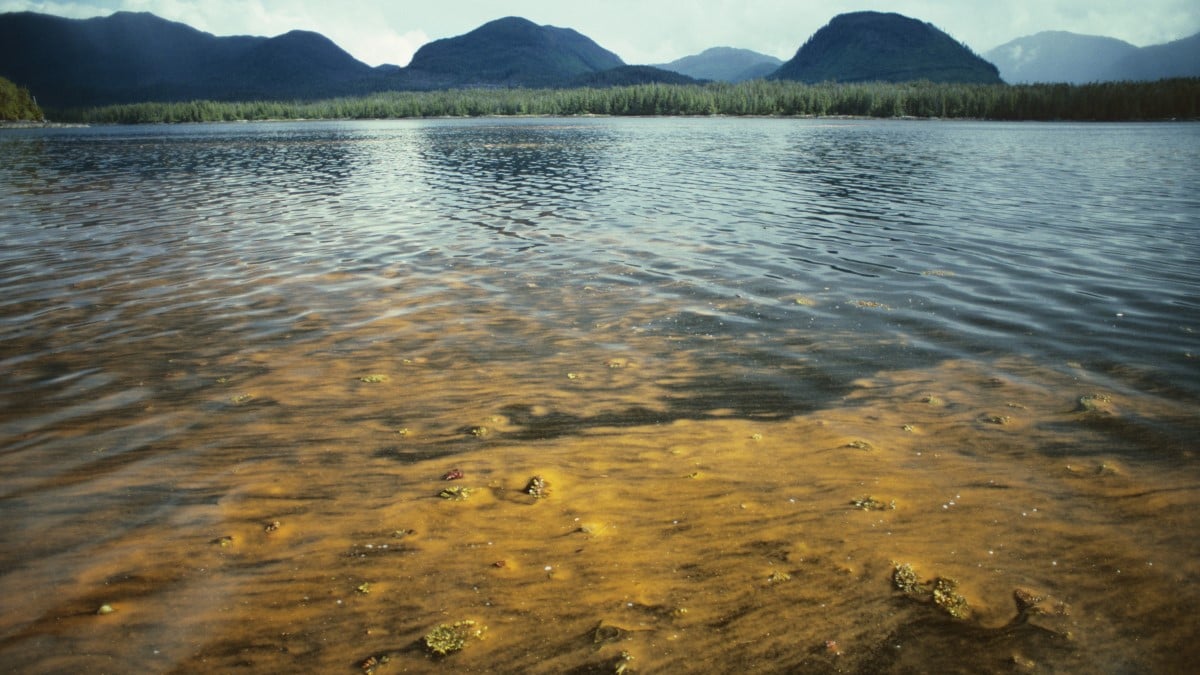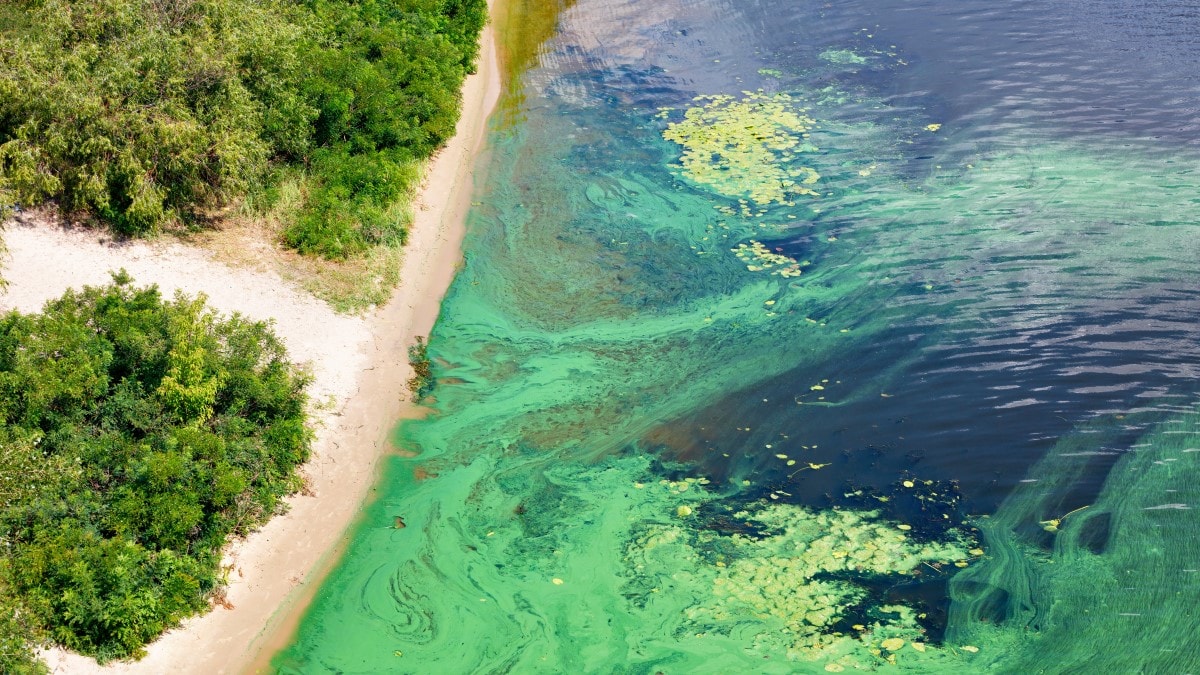Key points
- Harmful algal blooms are the rapid growth of algae or cyanobacteria in water that can harm people, animals, or the environment.
- Some harmful algal blooms make toxins that can cause mild to life-threatening illnesses.
- People are exposed primarily through ingestion of water or food, inhalation of water droplets, or skin or eye contact with water.
- There are no known antidotes, so you can help relieve patients’ symptoms by providing supportive medical care.

Background
Algae and cyanobacteria (also called blue-green algae) in water can quickly grow out of control, or "bloom."
Some of these blooms produce toxins that cause illnesses in people and animals.
Harmful algal blooms can grow in fresh water, salt water, or brackish water (a mixture of fresh and salt water). They are more likely to grow when water has high levels of nutrients like nitrogen and phosphorous. Harmful algal blooms occur across the United States and around the world.

Causes
Many different types of algae can cause harmful algal blooms.
However, four types of algae cause most blooms that make people and animals ill:
- Cyanobacteria
- Dinoflagellates
- Diatoms
- Sargassum seaweed
Cyanobacteria cause most harmful algal blooms in bodies of fresh water, like lakes or rivers. Less commonly, cyanobacteria can cause harmful algal blooms in salt or brackish water. Diatoms, dinoflagellates, and Sargassum species cause most harmful algal blooms in bodies of salt water or brackish water.
Cyanobacteria, diatoms, and dinoflagellates make various toxins that can cause illnesses. Sargassum seaweed landfalls can cause respiratory illnesses when they decay and release gases, such as hydrogen sulfide or methane.
Exposure risks
People can become ill from harmful algal blooms or their toxins through ingestion, skin or eye contact, or inhalation. In rare cases, dialysis patients have become ill after being exposed to dialysis water contaminated with harmful algal bloom toxins.
Ingestion:
- Swallowing water contaminated with a harmful algal bloom or its toxins
- Eating food contaminated with toxins
- Taking dietary supplements contaminated with toxins
Inhalation: breathing in aerosolized toxins or harmful gases from decaying algae (such as hydrogen sulfide or methane)
Skin contact: direct contact with contaminated water during activities like swimming or boating
Eye contact: direct contact with contaminated water or aerosols
Contact your local poison control center at 1-800-222-1222 for questions about exposures to harmful algal blooms.
People are most often exposed to cyanobacteria or their toxins while doing activities in or near water with a harmful algal bloom of cyanobacteria. People can also be exposed through contaminated tap water, seafood, blue-green algae dietary supplements, or, infrequently, dialysis.
People can be exposed to saltwater harmful algal blooms or their toxins while doing activities in or near contaminated water. People can also be exposed by eating contaminated shellfish or fish (see below).
Freshwater fish
More research is needed to better understand the risk of becoming ill from eating freshwater fish containing toxins made by cyanobacteria.
Saltwater fish and shellfish
People can become ill after eating seafood containing algal toxins. Shellfish in salt water or brackish water become contaminated with algal toxins when they filter toxins from contaminated water. Reef fish become contaminated through bioaccumulating toxins when they eat other animals that contain toxins.
Neurotoxic shellfish poisoning (NSP) is caused by brevetoxins that accumulate in bivalve shellfish (scallops, clams, mussels, oysters). NSP has been reported in temperate areas worldwide. This includes the southeastern coast of the United States, the Gulf of Mexico, the Caribbean, and New Zealand.
Ciguatera poisoning (CP) is caused by ciguatoxins that accumulate in reef fish (including barracuda, grouper, red snapper, and amberjack). Contaminated fish are most often from tropical coral reefs, including in the Caribbean, South Pacific Ocean, Indian Ocean, tropical Atlantic Ocean, and the Gulf of Mexico. Seafood and tropical fish eaten in or imported from those areas are potential sources of exposure.
Amnesic shellfish poisoning (ASP) is caused by domoic acid that accumulates in bivalve shellfish (scallops, mussels, razor clams [Siliqua patula], oysters, Dungeness crab viscera). Contaminated shellfish are mostly found in temperate waters of North America, South America, and Northern Europe.
Diarrhetic shellfish poisoning (DSP) is caused by okadaic acid, dinophysistoxins, or pectenotoxins that accumulate in bivalve shellfish (scallops, mussels, clams, oysters). Contaminated shellfish are found worldwide, but especially in Europe and Japan.
Paralytic shellfish poisoning (PSP) is caused by saxitoxin and neosaxitoxins. Sources include scallops, mussels, clams, oysters, cockles, whelks, pufferfish, herbivorous fish, blue-ringed octopus, Atlantic thorny lobster, Australian xanthid crab, and eggs of the horseshoe crab. Tetrodotoxin can also cause PSP when people eat the gonads or viscera of pufferfish, blue-ringed octopus, horseshoe crabs, salamanders, crab, sea worms, starfish, gastropod mollusks, or goby. The likely geographic distribution for contaminated shellfish and fish includes temperate areas worldwide. This includes the east and west coasts of the United States and Canada, Japan, Taiwan, southern Norway to Spain, Australia, British Columbia, South Africa, Guatemala, and Patagonia.
Azaspiracid shellfish poisoning (AZP) is caused by azaspiracid toxins that accumulate in bivalve shellfish (scallops, mussels, clams, oysters). Contaminated shellfish are most often from Europe and Japan.
Health effects
Harmful algal blooms cause a variety of mild to life-threatening illnesses.
Signs and symptoms depend on how a person was exposed, length of exposure, and type of toxin they were exposed to. Illnesses caused by harmful algal blooms in fresh water are often different than those caused by harmful algal blooms in salt water.
Prevention
People can take steps to avoid getting sick from harmful algal blooms. For example:
- Stay out of discolored, scummy, or smelly water.
- Check for and follow swimming, fishing, and shellfish advisories.
- Follow guidance from local officials if there is a harmful algal bloom in their drinking water supply.
- Talk with a health care provider before taking supplements containing blue-green algae or giving them to a child.
Testing and diagnosis
Illnesses caused by harmful algal blooms are primarily diagnoses of exclusion because of limited clinical testing for harmful algal bloom toxins. Asking your patient about exposures and using other available laboratory tests may help you diagnose illnesses caused by harmful algal blooms.
You can use the following codes to record your diagnosis of harmful algal bloom-associated illnesses:
- T65.82 Toxic effect harmful algae and algae toxins
- Z77.121 Contact with and (suspected) exposure to harmful algae and algae toxins
Symptom management
Treatment of illnesses caused by harmful algal blooms is supportive and symptom-directed. There are no known antidotes to harmful algal bloom toxins.
Reporting and data
Contact your local or state health department to report a harmful algal bloom-associated illness. Health departments voluntarily report these illnesses to CDC's national tracking system, the One Health Harmful Algal Bloom System (OHHABS).
Resources
- Cyanobacterial Blooms and Associated Illnesses: A Clinician Training Module for Physicians and Healthcare Providers | ASTHO
- Food Poisoning from Marine Toxins | CDC Yellow Book
- Health Effects from Cyanotoxins | U.S. EPA
- Sargassum Inundation Events: Impacts on Human Health | U.S. EPA
- Blue-Green Algae Products and Microcystins | FDA
- Distribution of Harmful Algal Blooms in the U.S. | Woods Hole Oceanographic Institution
